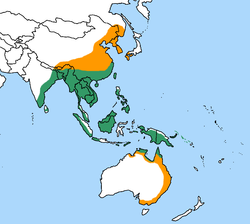| Oriental dollarbird | |
|---|---|
 | |
| Adult | |
| Scientific classification | |
| Kingdom: | Animalia |
| Phylum: | Chordata |
| Class: | Aves |
| Order: | Coraciiformes |
| Family: | Coraciidae |
| Genus: | Eurystomus |
| Species: | E. orientalis |
| Binomial name | |
| Eurystomus orientalis (Linnaeus, 1766) | |
 | |
| Distribution of the oriental dollarbird | |
| Synonyms | |
Coracias orientalisLinnaeus, 1766 | |
The Oriental dollarbird (Eurystomus orientalis) is a bird of the roller family, so named because of the distinctive pale blue or white, coin-shaped spots on its wings. It can be found from Australia to Korea, Japan and India.







